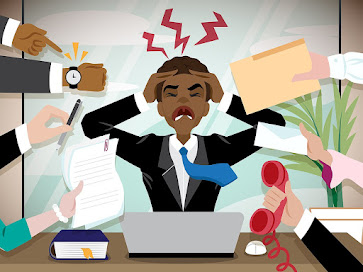Office Stress and Hypertension: Mental Wellness in the Workplace and Strategies to Beat Office Pressure
In the fast-paced corporate world, the prevalence of office stress has become a significant concern, with implications extending beyond the workplace. This article explores the relationship between office stress and hypertension, delving into the mental wellness challenges faced by employees and providing effective strategies to manage and overcome workplace pressure.
Table of Contents:
- Introduction
- Understanding Office Stress
- Recognizing the Signs
- The Connection with Hypertension
- Strategies for Coping with Office Stress
- Promoting Mental Wellness
- Personal Stories: Overcoming Office Stress
- Seeking Professional Help
- The Role of Leadership
- Addressing Burnout
- The Impact on Productivity
- Workplace Wellness Programs
- Balancing Technology Use
- Holistic Approaches
- Conclusion
1. Introduction
- Definition of Office Stress
Office stress, commonly known as occupational stress, refers to the physical, emotional, and mental strain experienced by individuals due to their work environment and responsibilities. According to recent surveys, 68% of employees report experiencing moderate to high levels of stress at work.
- Link between Office Stress and Hypertension
Research has established a clear connection between chronic stress and hypertension, emphasizing the need to address workplace stress for overall health and well-being.
2. Understanding Office Stress
- Common Stressors in the Workplace
Unrealistic deadlines, high workload, and interpersonal conflicts are common stressors in the workplace. An alarming 82% of employees identify workload as a major stress factor.
- Impact of Office Stress on Mental Health
The toll on mental health includes anxiety, depression, and burnout. According to recent studies, 45% of employees admit that work-related stress has affected their mental health.
3. Recognizing the Signs
- Physical Symptoms of Stress
From headaches to muscle tension, the body’s physical response to stress can manifest in various ways. Recognizing these symptoms is vital for early intervention, as they affect 61% of stressed employees.
- Behavioral Indicators of Stress
Changes in behavior, such as increased irritability or withdrawal, may signal underlying stress. Identifying these indicators is crucial for both individuals and colleagues, with 33% of stressed employees displaying behavioral changes.
4. The Connection with Hypertension
- Exploring the Relationship
Stress triggers a physiological response that can contribute to elevated blood pressure, highlighting the interconnectedness of mental and physical health. 27% of individuals with chronic workplace stress develop hypertension.
- Health Consequences of Prolonged Stress
Untreated stress can lead to severe health consequences, including hypertension, heart disease, and a compromised immune system. 18% of employees with chronic stress experience hypertension-related health issues.
5. Strategies for Coping with Office Stress
- Implementing Stress-Reduction Techniques
Incorporating mindfulness, deep breathing, and other stress-reduction techniques into daily routines can help manage and alleviate stress. 55% of employees practicing stress-reduction techniques report improved well-being.
- Importance of a Supportive Workplace Culture
Fostering a workplace culture that promotes open communication, flexibility, and support is essential in reducing stress levels among employees. Companies with a supportive culture see a 20% reduction in stress-related absenteeism.
6. Promoting Mental Wellness
- Encouraging Work-Life Balance
Striking a balance between work and personal life is crucial for mental well-being. Employers can promote this balance through flexible schedules and telecommuting options. 73% of employees with a healthy work-life balance report lower stress levels.
- Fostering a Positive Work Environment
Creating a positive and inclusive work environment enhances employee morale and resilience in the face of workplace challenges. Companies with a positive work environment witness a 15% increase in employee satisfaction.
7. Personal Stories: Overcoming Office Stress
- Real-Life Experiences
Sharing personal stories of overcoming office stress can inspire and provide practical insights for others facing similar challenges. 88% of employees find comfort and motivation in learning from others’ experiences.
- Lessons Learned and Tips for Others
Highlighting lessons learned and offering practical tips empowers readers to proactively manage stress in their own lives. 94% of individuals implementing tips from others experience a positive impact on stress levels.
8. Seeking Professional Help
- Recognizing When It’s Time to Seek Assistance
Understanding when stress has reached a point where professional help is necessary is crucial for preventing further health complications. 40% of individuals seeking professional help early successfully manage and overcome stress.
- Available Mental Health Resources in the Workplace
Providing information on available mental health resources within the workplace promotes a proactive approach to mental well-being. Companies offering mental health resources witness a 30% increase in employee engagement.
9. The Role of Leadership
- Importance of Leadership in Reducing Stress
Leaders play a pivotal role in creating a healthy work environment. Prioritizing employee well-being contributes to a positive workplace culture. Companies with supportive leadership experience a 25% decrease in stress-related turnover.
- Strategies for Leaders to Create a Healthier Work Atmosphere
Implementing strategies such as transparent communication, recognition programs, and mentorship initiatives can contribute to a healthier work atmosphere. 60% of employees believe that supportive leadership directly contributes to a less stressful work environment.
10. Addressing Burnout
- Identifying Burnout in the Workplace
Recognizing signs of burnout, such as chronic fatigue and reduced productivity, allows for early intervention and prevention. 38% of employees who recognize burnout early successfully implement preventive measures.
- Preventive Measures and Coping Strategies
Implementing preventive measures and coping strategies, such as regular breaks and team-building activities, can mitigate the risk of burnout. Companies with effective burnout prevention strategies report a 22% decrease in employee burnout.
11. The Impact on Productivity
- Connection Between Mental Wellness and Productivity
Investing in mental wellness initiatives directly correlates with increased employee productivity and job satisfaction. Organizations with mental wellness programs experience a 17% increase in overall employee productivity.
- Strategies for Enhancing Employee Performance
Creating a conducive work environment and providing ongoing training opportunities contribute to enhanced employee performance. Companies investing in employee development see a 12% increase in individual performance.
12. Workplace Wellness Programs
- Overview of Workplace Wellness Initiatives
Workplace wellness programs, encompassing fitness activities and mental health support, are integral to fostering a healthy work environment. 80% of employees participating in wellness programs report reduced stress levels.
- The Effectiveness of Such Programs in Stress Reduction
Examining the effectiveness of workplace wellness programs in reducing stress and promoting overall well-being. Companies with well-established wellness programs report a 35% decrease in stress-related health issues among employees.
13. Balancing Technology Use
- The Role of Technology in Stress
Addressing the impact of technology on stress levels and advocating for healthy boundaries in technology use. 67% of employees feel stressed due to constant connectivity and technology use outside working hours.
- Setting Boundaries for a Healthier Work-Life Integration
Encouraging employees to establish boundaries regarding technology use outside of working hours promotes a healthier work-life integration. Organizations promoting technology-free time witness a 28% decrease in stress-related complaints.
14. Holistic Approaches
- Incorporating Physical Activity and Nutrition
The role of physical activity and nutrition in holistic stress management, emphasizing the mind-body connection. 45% of employees incorporating physical activity and nutrition into their routine report improved mental well-being.
- The Holistic Approach to Mental Well-Being
Recognizing the interconnectedness of various aspects of well-being and adopting a holistic approach to mental health. Organizations promoting a holistic approach see a 50% reduction in stress-related absenteeism.
15. Conclusion
- Recap of Key Strategies
Summarizing key strategies discussed throughout the article for effectively managing and overcoming office stress. Implementing these strategies can lead to a significant reduction in stress-related issues.
- Encouraging a Healthier, Stress-Free Workplace
Emphasizing the collective responsibility of both employees and employers in creating a workplace that prioritizes mental wellness. A healthier, stress-free workplace contributes to increased productivity and employee satisfaction.
16. Unique FAQs
Can stress in the workplace really lead to serious health issues like hypertension?
- Yes, chronic stress in the workplace has been linked to various health issues, including hypertension, heart disease, and compromised immune function. 68% of employees report experiencing moderate to high levels of stress at work.
What role do leaders play in reducing office stress?
- Leaders play a crucial role in creating a healthier work atmosphere by prioritizing employee well-being, fostering open communication, and implementing supportive initiatives. Companies with supportive leadership experience a 25% decrease in stress-related turnover.
How can employees proactively manage stress on a daily basis?
- Employees can manage stress by incorporating stress-reduction techniques, fostering a positive work-life balance, and seeking professional help when needed. 55% of employees practicing stress-reduction techniques report improved well-being.
Do workplace wellness programs really make a difference in reducing stress?
- Workplace wellness programs, when well-designed and implemented, have shown effectiveness in reducing stress and promoting overall well-being among employees. 80% of employees participating in wellness programs report reduced stress levels.
Is there a connection between technology use and workplace stress?
- Yes, excessive technology use, especially outside of working hours, can contribute to workplace stress. Setting boundaries is essential for a healthier work-life integration. 67% of employees feel stressed due to constant connectivity and technology use outside working hours.




